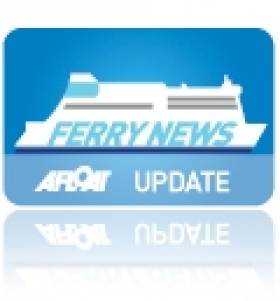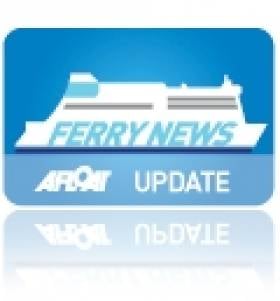Displaying items by tag: BelfastStranraer
Stena Sale Ferry to Spanish Operator
#FERRY NEWS- Stena Navigator which served on the former Belfast-Stranraer route, has been sold to overseas buyers. She was one of three ferries made redundant following the switch pf ports to a new ferry terminal in Cairnryan and introduction of larger vessels, writes Jehan Ashmore.
Having only been introduced on the North Channel in late 2009, Stena Navigator (PHOTO) is now set to embark on a new career in the Mediterranean with Spanish operator Baleària. The company operates routes linking the islands to the Spanish mainland in addition to the Strait of Gibraltar, where the ferry is to start service.
The 1,650-passenger, 280-vehicle capacity vessel is currently berthed at Albert Quay, Belfast, before she makes her delivery voyage.
Launched in 1984 as Champs Elysees at Dubigeon Normandie, Nantes Saint Nazaire, for SNCF's Dover-Calais route. She then spent service Stena Line as Stena Parisien between Newhaven-Dieppe before been sold to SeaFrance. This saw her return to the Dover Strait as SeaFrance Manet until eventually sold back to Stena Line.
Berthed ahead of the 15,229grt ferry is her former fleetmate Stena Caledonia, built at the nearby Harland & Wolff and upriver the HSS Stena Voyager is berthed at VT4 Terminal. Since been laid-up the vessels were transferred to a Stena subsidiary, Northern Marine Management (NMM).
Historic Days on North Channel Ferry Routes
#FERRY NEWS- In the space of two days, Stena Line opened a new ferry route between Belfast-Cairnryan today following yesterday's closure of services between Belfast-Stranraer, writes Jehan Ashmore.
Sisters Stena Superfast VII and Stena Superfast VIII inaugurated sailings on the 2 hour 15 minute with 12 crossings daily, and in which will use a new £80m ferry terminal at Loch Ryan Port, Cairnryan and the VT4 terminal in Belfast. The relocation of Scottish ports and terminal investment cost £200m.
The newcomers have a capacity for 1,200 passenger /660 vehicles or 110 freight units. They received a refit and upgrade in Poland where new luxurious facilities such as a Nordic Spa, interactive lounge zone with the latest in technology and free Wi-Fi access throughout the vessel and VIP lounges were installed. To read more click HERE.
At 204m and over 30,000 tonnes each the German built pair are easily the largest ever ferries to operate in the North Channel and will compete with rivals P&O Larne-Cairnryan route served by the 20,000 tonnes sisters European Causeway and European Highlander both built in Japan.
The introduction of the former Scandinavian serving sisters directly replaced Stena Caledonia and HSS Stena Voyager from the Belfast-Stranraer route which only started in 1995. Prior to then Stena Line had operated a service from Larne, which could trace ferry services for the last 123 years.
The Swedish ferry company decided to abandon the route in favour of Belfast. This development also saw the introduction of the second revolutionary HSS 1500 series catamaran ferry HSS Stena Voyager in tandem with various conventional tonnage used over the last sixteen years. The final sailings at the weekend marked the closure of nearly 140 years of several ferry operators running between Stranraer at the end of Loch Ryan and Belfast.
With the withdrawal of HSS Stena Voyager and Stena Caledonia yesterday, she joins former fleetmate Stena Navigator in Belfast, which stood down from Stranraer service last week as previously reported, to read click HERE.
Award Winning Stena Line Look Forward to New Northern Route
"We are moving into a very important time for Stena Line's operation between Northern Ireland and Scotland. On November 21 we are scheduled to start our new Belfast to Cairnryan service which will also see the introduction of two new vessels, Stena Superfast VII and Superfast VIII, the largest ships every to have sailed between Northern Ireland and Scotland," he continued.
Stena Line's switch of Scottish terminal from Stranrear to the new purpose built facility in Cairnryan which is some 8-miles closer to the open sea along Loch Ryan will reduce sailing times by 35 minutes down to 2 hours 15 minutes.
The 30,285grt Stena Superfast VII and Superfast VIII sisters can carry 1,200 passengers, 660 cars and 110 freight-unit / trucks. In addition they have a novel Nordic Spa facility incorporating a sauna and Jacuzzi.
The 206m pair will compete with rivals P&O (Irish Sea) which operates also from a neighbouring terminal in Cairnryan where another pair of sisters European Highlander and European Causeway provide 2-hour sailings to Larne.
Currently Belfast-Stranraer sailings are served by conventional tonnage ferries Stena Caledonia and Stena Navigator which lost engine-power on 14 October, to read more click HERE.
In addition fast-sailings are run by the expensive to operate HSS Stena Voyager which manages a faster crossing time on the existing route by shaving 15 minutes off the link between Loch Ryan and Belfast Lough. In 2008 the terminal in Belfast was relocated downriver to Victoria Terminal 4 (VT4) on the eastern edge of the port from the older inner-city terminal at Albert Quay.
Stena are to lease the 'Superfast' pair for three years from Scandinavia operator Tallink and they are to directly replace both the HSS and conventional ferries.
P&O Close Seasonally Operated Fast-Ferry Services
As for the remaining winter-serving fast-ferries they are Stena Line's HSS Stena Voyager (1996/ 19,638grt) between Belfast-Stranraer, in tandem with conventional ferries. Next month this route will close as the Scottish terminal relocates to a new ferryport nearby at (Loch Ryan Port) Cairnryan.
In addition two sister-ferries, which are undergoing modifications and an upgrade for their two-year charter on the North Channel, will directly replace the two-hour passage times it takes for the HSS fast-ferry and the ferries Stena Caledonia and Stena Navigator which take 2hrs 50 minutes.
With the introduction of the new tonnage to the Belfast-Cairnryan route, sailings times will be reduced to 2hrs 15mins. Ironically the new ferries which albeit will be the largest to serve on any North Channel route will actually be some 15 minutes slower on the newer-shorter distance route compared to the HSS fast-ferry operated Belfast-Stranraer sailings.
The second fast-ferry service is operated on Irish Ferries Dublin-Holyhead route using Jonathan Swift (1999/5,989grt) which is marketed as the Dublin 'Swift'. She runs year-round in addition to the cruiseferry Ulysses.
Also operating fast-ferry craft is the Isle of Man Steam Packet Company's Manannan (1998/5,029grt) but this is on the none cross-channel route between Douglas and Liverpool.
Family Fun Day Cruise’s from Belfast
The 'cruise' onboard the ferry Stena Navigator (for virtual tour click HERE) is based on a return excursion on the North Channel route.
So what's included?...there's live music, disco / karaoke, face-painting, balloon modeling and party games for the children. For further family entertainment there's even a magician, Wii-games, free movies and free Wi-Fi.
In addition a 10% discount is available from the onboard shop, though exclusions apply.
Cruises are not catered for vehicles but apply to 'foot' passengers, for further details on terms and conditions, cruise itinerary and travel dates click HERE.

































































